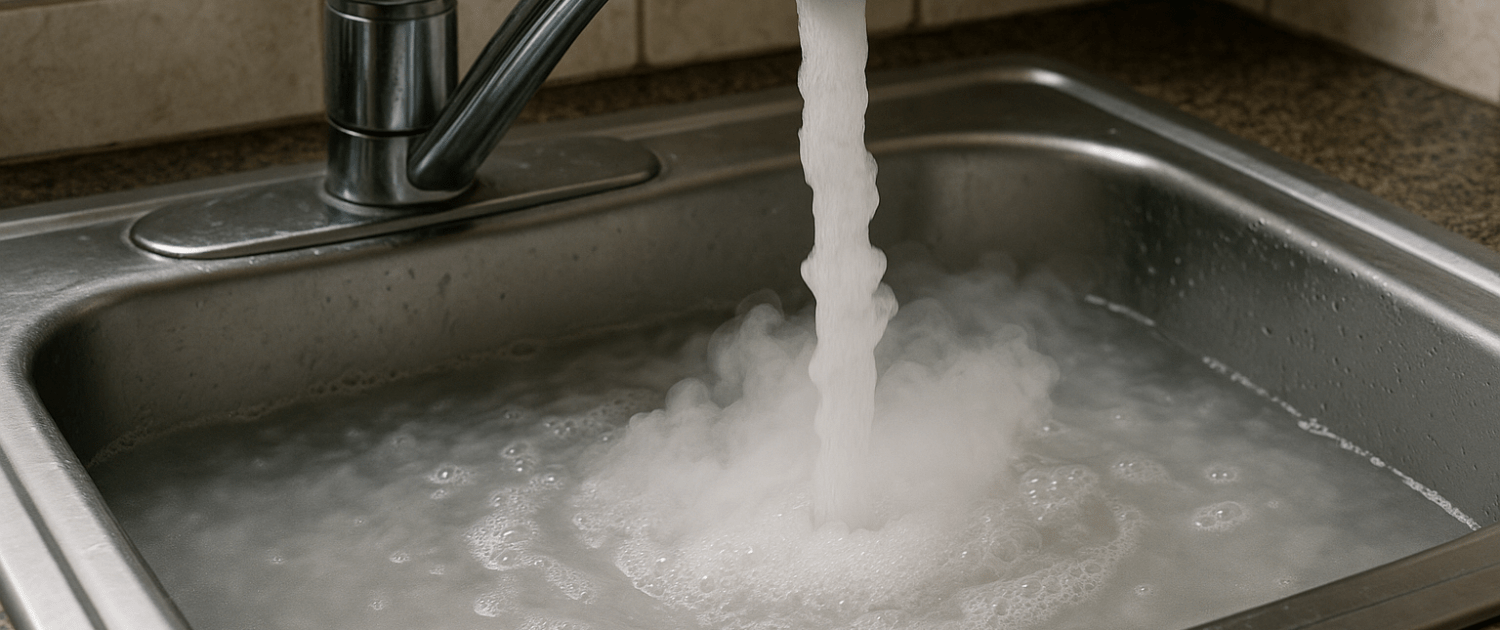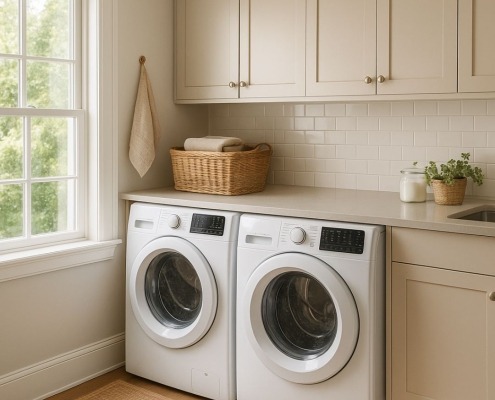How to Fix Cloudy or Bad Tasting Reverse Osmosis System Water
Steven E / Monday May 5, 2025
You invested in a reverse osmosis (RO) system to get clean, crisp, great-tasting water at home, but suddenly, the water tastes… off. Or it looks cloudy. Maybe there’s a strange chemical taste, a bit of funkiness, or just something that makes you want to pour it down the drain instead of drink it. The good news? In most cases, bad-tasting or cloudy water can be fixed quickly with a few simple steps, no plumber needed.
We’ll walk you through how to troubleshoot bad-tasting or cloudy water from your reverse osmosis system, figure out what’s causing it, and give you easy DIY solutions to get your water fresh and clean again.
If you find out that you need any replacement parts for your appliance while you’re troubleshooting, you can enter your model number at AppliancePartsPros.com to order them. Most orders arrive in just two business days, and we have thousands of free guides to show you how to install your new parts.
The information in this article may not apply to your specific appliance model. We recommend consulting your manufacturer’s documentation or contact us with any questions.
Common Signs of a Problem
Let’s start by identifying exactly what you’re dealing with. Some of the most common water issues from a reverse osmosis system include:
- Cloudy or milky water
- Metallic, bitter, or chemical taste
- Rotten egg smell
- Chlorine or plastic-like flavor
- Water that tastes flat or stale
Each of these symptoms can point to a different issue, but most are easy to troubleshoot on your own.
Step 1: Check the Age of Your Filters
The most common reason for bad-tasting or cloudy water? Old or clogged filters.
A reverse osmosis system typically has three to five stages, including:
- Sediment filter
- Carbon pre-filter
- RO membrane
- Carbon post-filter
- (Optional) Remineralization or polishing filter
Each filter has a lifespan, and once it hits that limit, performance drops, and your water starts to suffer.
When to replace filters:
- Sediment & carbon filters: every 6–12 months
- RO membrane: every 2–3 years
- Post-carbon filter: every 6–12 months
- Remineralization filters: every 6–12 months
If you can’t remember the last time you changed your filters (or you’ve never done it), that’s your first step. Replace them all according to the manufacturer’s schedule.
After installing new filters, flush the system completely before drinking the water.
Step 2: Flush the System
If you’ve recently changed filters or just installed a new system, the water may taste weird or look cloudy at first. This is completely normal.
New carbon filters can release carbon dust, and the RO membrane may need time to settle.
How to flush your RO system:
- Turn on the faucet connected to your RO system.
- Let it run for at least 5–10 minutes, or until the storage tank empties.
- Allow the tank to refill completely and flush it two to three more times.
This helps clear out carbon dust, preservatives, or other harmless (but bad-tasting) residues.
Step 3: Check the Storage Tank
The RO system’s pressurized storage tank holds filtered water until you need it. But over time, the inside of the tank can develop bacteria or odors, especially if the system hasn’t been used regularly.
Signs your tank might be the issue:
- Water tastes metallic or stale
- Water looks clean but smells off
- You’ve had the system for years and never cleaned the tank
What to do:
- Turn off the system and shut off the water supply.
- Empty the tank by opening the RO faucet.
- Remove the tank from the system if possible.
- Sanitize the tank using unscented bleach or hydrogen peroxide.
- Add 1 tablespoon of bleach or 1/4 cup of 3% hydrogen peroxide through the tank valve.
- Fill the tank with clean water and let it sit for 30 minutes.
- Drain and flush thoroughly before reconnecting.
- Do this once a year to keep things fresh and prevent bacterial growth.
Step 4: Inspect the RO Membrane
The reverse osmosis membrane is the heart of your system. It removes up to 99% of dissolved solids, but over time, it can become clogged or damaged, especially if the pre-filters aren’t changed regularly.
Signs the membrane is worn out:
- Water tastes salty, bitter, or like tap water
- Cloudy water with no other explanation
- TDS (total dissolved solids) levels are high
You can test TDS levels using a simple TDS meter (cheap and easy to use). RO water should have TDS below 50 ppm, if it’s climbing higher, your membrane is probably due for replacement.
Membranes typically last 2–3 years, but this depends on your water quality and usage.
Step 5: Check for Air Bubbles (Cloudy Water)
If your water looks cloudy or milky but clears up after sitting in a glass for a few minutes, you’re probably just seeing tiny air bubbles, not a contamination issue.
This can happen when:
- Filters were just changed
- The storage tank is refilling
- Pressure changes introduced air into the lines
What to do:
- Run and flush the system a few more times.
- Let the tank refill fully before use.
- Try leaving water in a glass for a few minutes to see if the cloudiness disappears.
If the cloudiness doesn’t go away or gets worse, keep troubleshooting below.
Step 6: Check for Bacterial Contamination
If your RO water smells like rotten eggs, musty earth, or has a slimy texture, it may have bacterial contamination. This can happen if:
- The system hasn’t been used regularly
- The storage tank is dirty
- The filters were overdue for replacement
- The system was exposed to contaminated water during installation or plumbing work
How to fix it:
- Sanitize the entire system (not just the tank).
- Turn off the water supply.
- Disconnect all filters and the membrane.
- Clean housings and tubing with a diluted bleach solution (1 tbsp bleach per gallon of water).
- Rinse thoroughly and reinstall everything with new filters.
It’s a bit of a process, but this deep clean can completely eliminate lingering smells and bad tastes.
Step 7: Replace the Post-Carbon Filter
The post-filter, also known as the polishing filter, is the last step before water reaches your glass. It improves taste and smell.
If everything else checks out and the water still tastes a little flat, plasticky, or weird, the post-carbon filter may be the issue.
Replace if:
- It’s older than 6–12 months
- You changed your other filters but skipped this one
- The water smells or tastes like chemicals or plastic
Always use high-quality replacement filters, cheap ones can cause more problems than they solve.
Step 8: Examine the Plumbing and Tubing
Sometimes the issue isn’t in the filters, it’s in the tubing, faucet, or fittings.
Things to check:
- Are any hoses or fittings made from low-quality plastic? These can leach odors or chemicals into the water.
- Does the faucet smell weird after sitting unused overnight?
- Is the tubing old, yellowing, or cracked?
What to do:
- Replace old tubing with food-grade, BPA-free tubing.
- Consider upgrading to a stainless steel RO faucet.
- Flush the faucet and tubing thoroughly with clean water after changing parts.
Step 9: Test Your Incoming Water
Sometimes the source of bad taste isn’t the RO system, it’s your incoming tap water. High levels of chlorine, sulfur, or minerals can overwhelm your system and wear out filters quickly.
You can test your tap water for:
- Chlorine
- Iron
- Sulfur
- Hardness
- TDS (total dissolved solids)
Test kits are available online and are easy to use. If your source water has major issues, consider adding pre-filtration (like a whole-house sediment or carbon filter) to help your RO system last longer.
Additional information
Thanks for reading! If you need replacement parts for any of your appliances, check out AppliancePartsPros.com, where you can enter your model number to find exactly what you’re looking for. Most orders arrive in two business days, and we have thousands of free resources to show you how to install your new parts.
You can also reach our award-winning customer service team at 1-877-477-7278, chat with a pro on our website and watch thousands of free video tutorials on our YouTube channel.
With nearly a decade of experience in providing top-notch customer service regarding appliance parts and repair, Steven enjoys sharing practical advice, troubleshooting tips, and interesting information to help readers stay informed.





